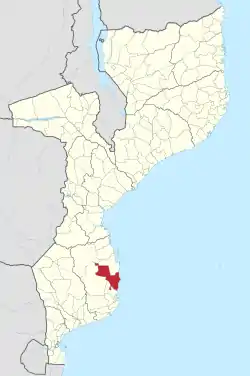Massinga District
Massinga District is a district of Inhambane Province in south-east Mozambique. Its principal town is Massinga. The district is located at the east of the province and borders with Inhassoro District in the north, Vilanculos District in the northeast, Morrumbene District in the south, and with Funhalouro District in the west. In the east, the district is bounded by the Indian Ocean. The area of the district is 7,458 square kilometres (2,880 sq mi). In terms of the area, this is the biggest district of Inhambane Province.[1] It has a population of 184,531 as of 2007.[2]
Massinga | |
|---|---|
 Massinga District on the map of Mozambique | |
| Country | Mozambique |
| Province | Inhambane |
| Capital | Massinga |
| Area | |
| • Total | 7,458 km2 (2,880 sq mi) |
| Population (2007 census) | |
| • Total | 184,531 |
| • Density | 25/km2 (64/sq mi) |
Geography
There are no rivers in the district which flow throughout the whole year, only streams generated by rain.[1]
The climate is tropical arid in the interior, with the annual rainfall varying between 650 millimetres (26 in) and 750 millimetres (30 in), and tropical humid at the coast, with the annual rainfall being 1,200 millimetres (47 in).[1]
History
In 1894, Massinga Military Command was established, thus bringing part of the area under the control of the military. In 1897, this part was subordinated to Gaza District, and in 1907, it was transferred to Inhambane District, thus bringing all current area of Massinga District, under both civil and military rule, into Inhambane District. Later in the same year, the military rule was abolished, and Massinga Circunscrição, a type of administrative unit used in Portuguese colonies in Africa, was established. In July 1986, a new administrative division of Mozambique was introduced, and Massinga District was established.[1]
Administrative divisions
The district is divided into two postos, Massinga (three localities) and Chicomo (two localities).[1]
Demographics
As of 2005, 43% of the population of the district was younger than 15 years. 17% did speak Portuguese. The population was predominantly speaking Chopi language. 59% were analphabetic, mostly women.[1]
Economy
In 2005, 1% of the households in the district had electricity.[1]
Agriculture
In 2005, the district had 42,000 farms exploiting on average the area of 1.3 hectares (0.0050 sq mi) each. The main agricultural products are maize, cassava, cowpea, peanuts, sweet potatoes, cotton, and rice.[1]
Transportation
There is a road network in the district which includes the 90 kilometres (56 mi) stretch of the national road EN1, crossing the eastern part of the district, and about 600 kilometres (370 mi) secondary roads.[1]
References
- "Perfil do Distrito de Massinga" (PDF) (in Portuguese). Ministry of State Administration. 2005. Archived from the original (PDF) on 22 October 2016. Retrieved 22 October 2016.
- "População da Provincia de Inhambane". Censo 2007 (in Portuguese). Instituto Nacional de Estatística. Archived from the original on 8 March 2008. Retrieved 20 March 2008.